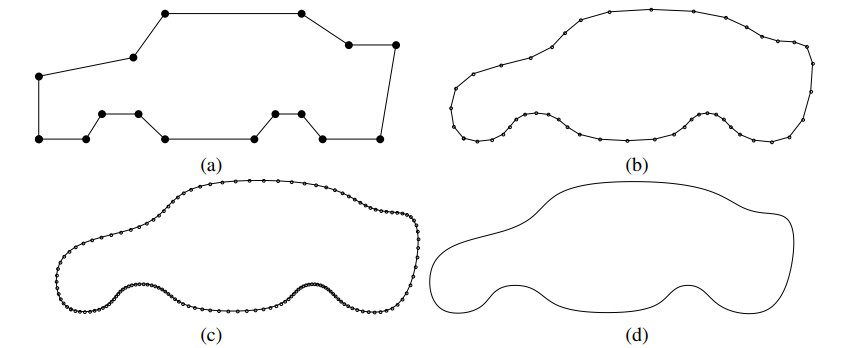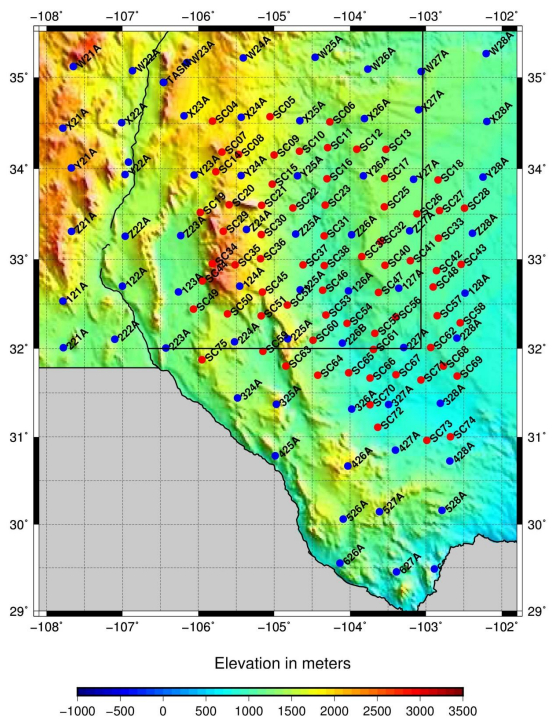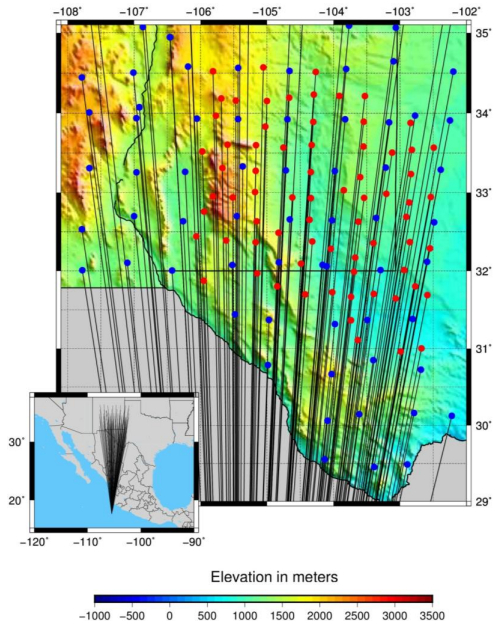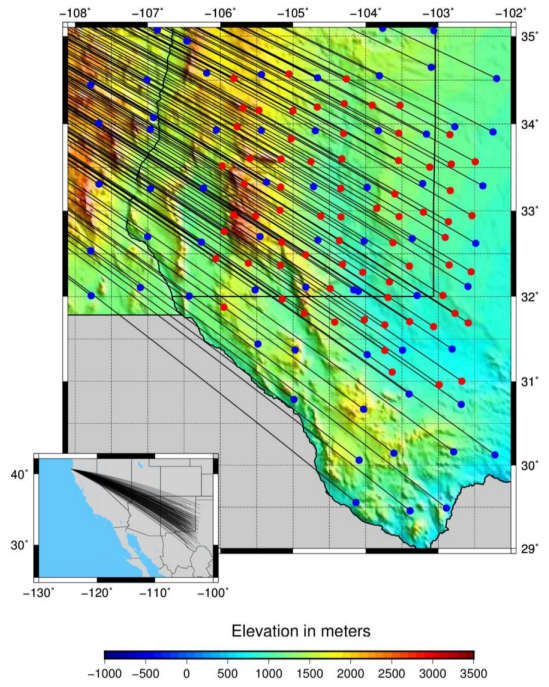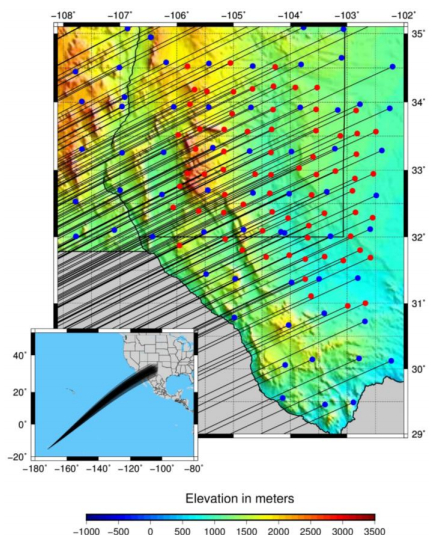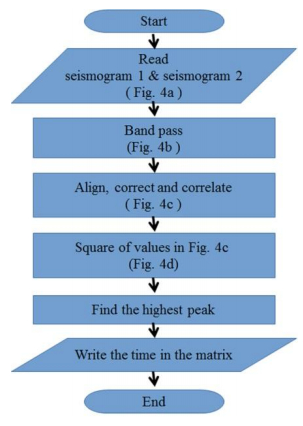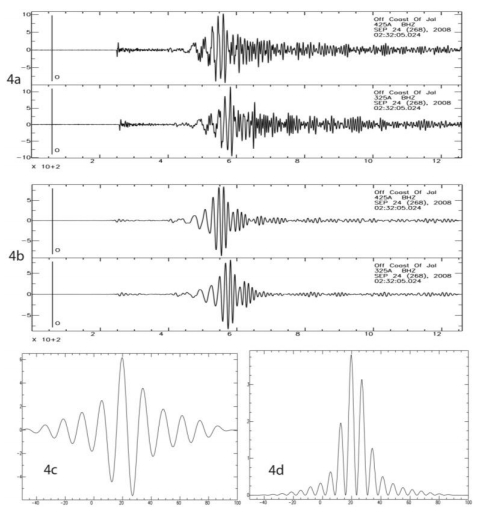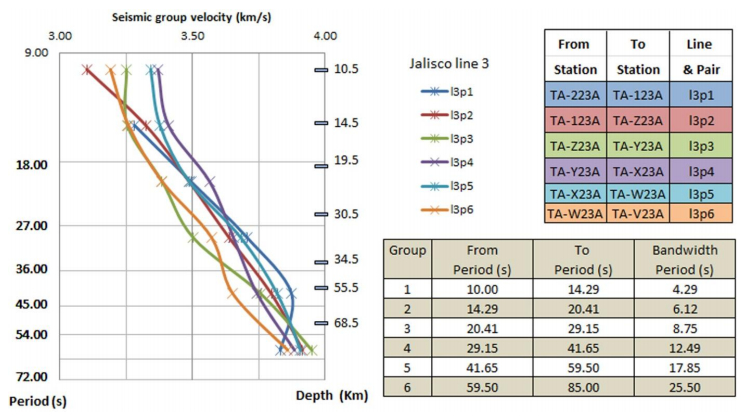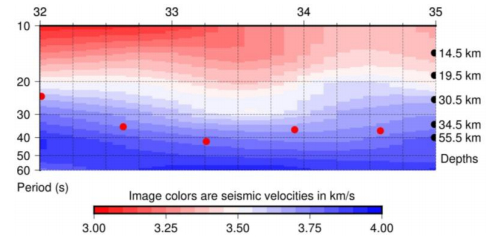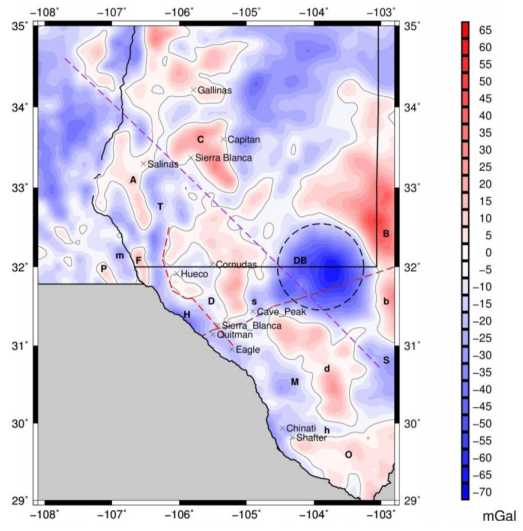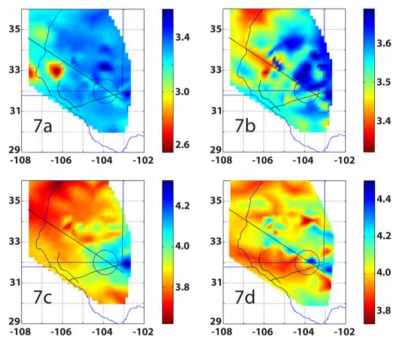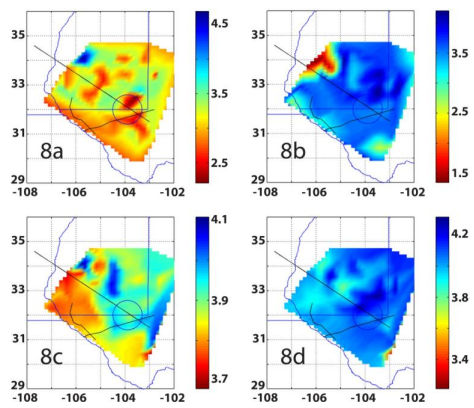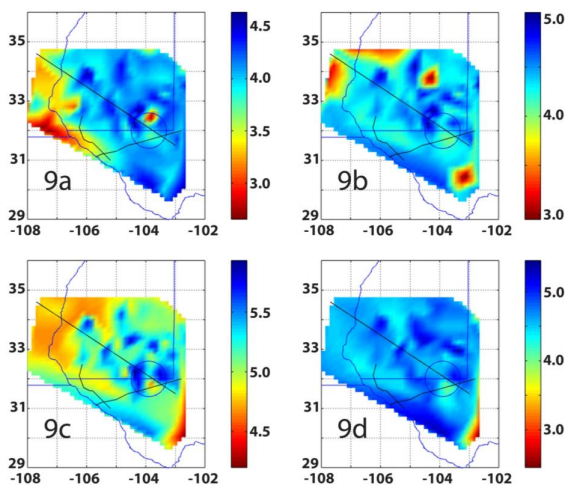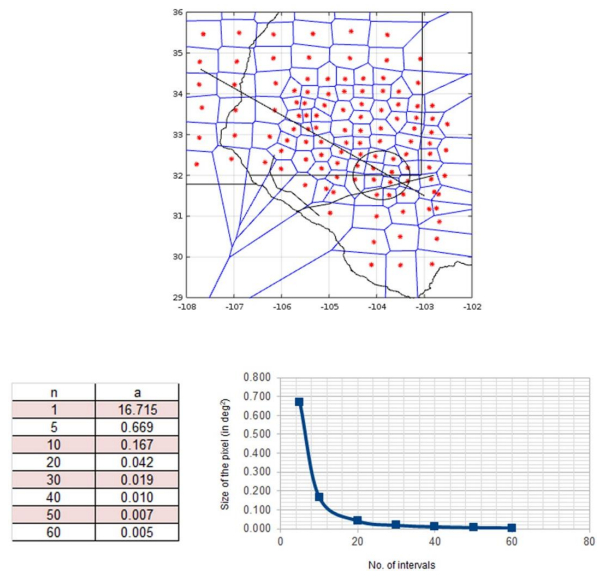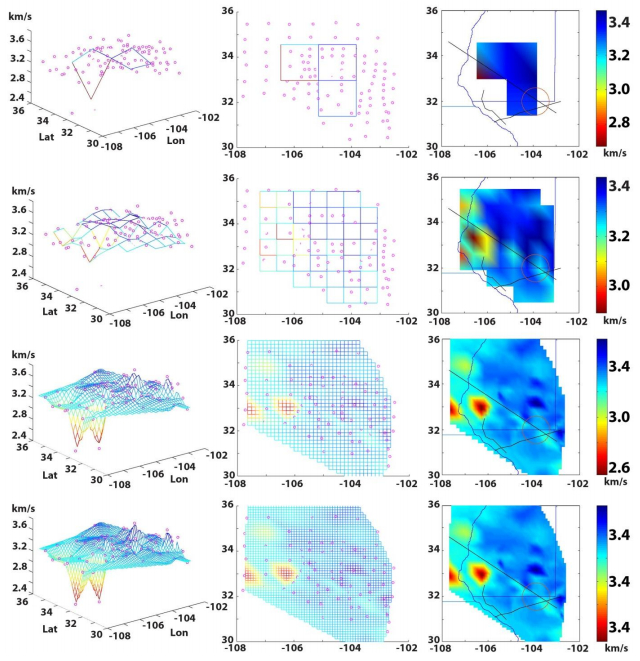The southeast shoulder of the Rio Grande Rift is located in southeastern New Mexico and west Texas in US and northern Chihuahua in Mexico. Noted mineral resources in the region are enriched in rare earth elements increasing the interest of research. These resources are related to tertiary volcanism. The magmas of this volcanism have similar composition of that of the oceanic island basalts suggesting that they were created from asthenosphere derived magmas from the basement of the North American Craton. That basement, in the area of interest, constitutes the Mazatzal and Grenville Proterozoic provinces of the Proterozoic Laurentia plate. This study is intended to contribute to the general understanding of the basement features of the region. In order to understand the structure of the crust and upper mantle we create a Rayleigh surface wave group velocity model of the southeast flank (or shoulder) of the Rio Grande Rift. Rayleigh wave group velocities were calculated using data from EarthScope’s TA and Flex arrays. The periods of the model range from 10 s to 160 s. The kernels of the model are taken from the joint inversions made for LA RISTRA, from where the depths corresponding to periods between 10 s to 160 s should be approximately between 10 km and 350 km of depth. The results show the anisotropy of the region and difficulties faced using the Rayleigh wave cross correlation. Some structures like the Delaware basin are complicated and sensitive to seismic radiation directions and patterns. In general, structures are better resolved when these radiation directions are perpendicular to the structure boundaries.
1.
Introduction
The refinement schemes can be viewed as a class of iterative algorithms. The main feature of these schemes is that they use initially the rough sketch of any curve called polygon to finally produce smooth sketch also called refined sketch. Initially, a refinement scheme was introduced by de Rahm [3] in 1956. Later on, Chaikin [1] introduced the scheme for curve generation in 1974. Deslauriers and Dubuc presented the interpolating schemes for curve modeling in 1989. This triggered off the modern era for the investigation of the refinement schemes. These refinement schemes have been used for curve and surface modeling for a long time by designers, engineers, computer scientists and mathematicians. The details of these applications are presented by Farin [7].
Initially, the binary refinement schemes were introduced. These schemes have two rules to refine each edge of the polygon. These rules are same for each edge of the polygon except the initial and final edges. These rules are classified as even and odd rules. These schemes take initial sketch as an input and return the refined sketch as an output. In the next step, these schemes take previously refined sketch as an input and produce more refined sketch. Repeated application of this procedure give the smooth curve/shape. Nowadays, there are many generalizations of the binary schemes. The class of ternary refinement schemes is one of the generalization of the class of binary schemes. In this class of the schemes, three rules are used instead of two rules to refine each edge of the polygon.
The analysis of the schemes is the crucial issue. Initially, Dyn et al. [4], introduced the divided difference (DD) technique to analyze the schemes in 1987. Later on, Dyn et al. [5], extended this technique for the analysis of the class of binary schemes in 1991. The study of the limiting curves produced by the binary refinement schemes was also presented by Micchelli and Prautzch [11] in 1989. Sabin [15] in 2010, gave further insight in this technique. The further extension of Dyn et al.'s work was done by Mustafa and Zahid [12] in 2013. The cross-differences of directional DD techniques was introduced by Qu [14] in 1991. The further generalization of the DD technique has not been done so for.
Another technique for the smoothness analysis of the schemes was introduced by Dyn [6] in 2002. This technique is known as Laurent polynomial technique. This technique was used by Hassan and Dodgson [8], Hassan et al. [9], Mustafa et al. [13]. Khan and Mustafa [10], Siddiqi and Rehan [16], Zheng et al. [17] and many others to analyze their binary and ternary refinement schemes. Nowadays many authors are also using this technique. However, this technique also has some limitations and need improvement. In this technique, first a sequence of coefficients used in the refinement rules of the schemes is converted into the polynomial. Secondly, the polynomial has been factorized. In this technique, multiplication, division, factorization of the polynomials are involved. Further, the computation of inequalities and the comparison of the terms are also involved. The technique, we are going to introduce is the generalization of DD technique. In this technique, the computation of inequalities and the comparison of three terms are involved. There are three simple algebraic expressions in each inequality. Further these algebraic expressions contain only the coefficients used in the refinement rules of the schemes.
The rest of this paper is structured as follows. In Section 2, a general ternary refinement scheme and its DD schemes are introduced. Their convergence is also presented in this section. In Section 3, the deviation between successive levels of polygons produced by the ternary and its DD refinement schemes are presented. The inequalities for the analysis of ternary schemes are presented in Section 4. Applications of these inequalities are also presented in this section. Summary of the work and comparison are presented in Sections 5 and 6 respectively.
2.
Ternary and its DD refinement schemes
We first introduce the ternary and its first, second and third order divided differences (DD) refinement schemes. Then we present their convergence in this section.
2.1. Ternary refinement scheme (TRS)
Let fk={(i/3k,fki)∈RN, i∈Z, N≥2, k≥0}, be a polygon at kth refinement level then the (k+1)th polygon fk+1, can be obtained by the following three refinement rules
whereas m>0 while if tki=i/3k then (tk+13i=tki, fk+13i), (tk+13i+1=13(2tki+tki+1), fk+13i+1)
and (tk+13i+2=13(tki+2tki+1), fk+13i+2) are the points of the polygon fk+1.
The above rules are the affine combinations of fki's so
The one step of the refinement procedure is shown in Figure 1. The repeated application of these rules is known as ternary refinement scheme.
2.2. First to third order DD refinement schemes
The first, second and third order divided difference (DD) ternary refinement schemes (TRS) are presented in this section.
Lemma 2.1. Let fk={(i/3k,fki)} be a polygon of TRS at kth refinement level and d[1]kj=3k(fkj+1−fkj) be the first divided difference then the first order DD TRS is defined as
Proof. Since the first order DD is defined as
therefore by (2.1), we get
Now consider the linear combination
The goal is to find the unknown y0,⋯,ym−1. It can be written as
Comparing (2.5) and (2.7), we get
Substituting in (2.6), we get
This implies
Similarly, we get
and
This completes the proof. By adopting the similar procedure, we get the following results.
Lemma 2.2. Let fk={(i/3k,fki)} be a polygon of TRS at kth refinement level and
be the second order divided difference then the second order DD TRS is defined as
Lemma 2.3. Let fk={(i/3k,fki)} be a polygon of TRS at kth refinement level and
be the third order divided difference then the third order DD TRS is defined as
2.3. The convergence of ternary and its DD refinement schemes
The convergence of first, second and third order divided difference (DD) ternary refinement schemes (TRS) is presented in this section. Throughout the paper, π[0,n] denotes the set of continuous functions on the closed and bounded interval [0,n].
Lemma 2.4.
Let fk={(i/3k,fki)} be a polygon of TRS at kth refinement level and d[1]k={(i/3k,d[1]ki)} be a polygon of first order DD scheme. If limk→∞d[1]k=d[1]∈π[0,n], and f is the limiting curve/shape produced by TRS then d[1]=f′.
Proof. Bernstein polynomial for x∈[0,n] with data values fki is
Its first derivative is
This implies
For s=3kn, we get
This again implies
Since the Bernstien polynomials are uniformly convergent therefore limk→∞Bk=f and limk→∞B′k=d[1] on [0,n]. So f′=d[1]∈π[0,n]. Hence the proof.
Lemma 2.5. Let fk={(i/3k,fki)} and d[2]k={(i/3k,d[2]ki)} be the polygons of TRS and its second order DD schemes respectively. If limk→∞d[2]k=d[2]∈π[0,n], and f is the limiting curve produced by TRS then d[2]=f″.
Proof. Take the derivative of (2.10)
This implies
Since s=3kn therefore s(s−1)n2=32k2−1, so we get
This implies
where d[2]ki+1 = 32k(2!)−1(fki+2−2fki+1+fki).
Again the uniform convergence of the Bernstien polynomials implies limk→∞B″k=d[2] and limk→∞Bk=f. Therefore when k→∞ then d[2] converges uniformly to f″ on [0,n]. This concludes d[2]=f″∈π[0,n]. Hence the proof.
Lemma 2.6. Let fk={(i/3k,fki)} and d[3]k)={(i/3k,d[3]ki)} be the polygons of TRS and its third order DD schemes respectively. If limk→∞d[3]k=d[3]∈π[0,n] then d[3]=f‴.
Proof. Now take the derivative of (2.11), then
Since, s=3kn, then
This implies
where
This implies B‴k→d[3] and Bk→f. This implies that for k→∞ the d[3] converges uniformly to f‴ on [0,n]. This concludes that d[3]=f‴∈π[0,n]. Hence the proof.
3.
The deviation of ternary and its DD refinement schemes
We first introduce the inequalities to compute the deviation between two consecutive points at the same refinement level then we introduce the inequalities to compute the deviation between successive levels of polygons produced by ternary and its DD refinement schemes.
Lemma 3.1. If f0={(i/30,f0i)} is the initial polygon and fk+1={(i/3k+1,fk+1i)} is the polygon obtained by TRS at (k+1)th refinement level. If ϖ<1 then the deviation between two consecutive points at (k+1)th level is
where
Proof. From (2.1), we get
This further implies
This leads to
Since by (2.2), m∑ν=0(ϱν−ρν)=0, then
By taking maximum norm, we get
where
Using (2.1) and similar procedure as above, we get
where
and
where
Combining (3.4), (3.5) and (3.6), it proceeds as
where
This concludes
This completes the proof.
Theorem 3.2. If f0={(i/30,f0i)} is the initial polygon and fk+1={(i/3k+1,fk+1i)} is the polygon obtained by TRS at (k+1)th refinement level. If ϖ∗<1 then the deviation between two successive polygons at kth and (k+1)th levels is
where
Proof. Since the maximum deviation between fk+1 and fk occurs at the diadic values tk+13i=tki, tk+13i+1=13(2tki+tki+1) and tk+13i+2=13(tki+2tki+1) respectively, therefore
where
From (2.1), we obtain
Since by (2.1), m∑ν=0ρν−1=0, then
Taking norm, we get
where
Using (2.1) and similar procedure as above, we get
where
where
From (3.10)-(3.14), we get
where
Hence the proof.
Lemma 3.3. If d[1]0={(i/30,d[1]0i)} is the initial polygon and d[1](k+1)=
{(i/3k+1,d[1](k+1)i)} is the polygon obtained by first order DD TRS at (k+1)th refinement level. If ϖ∗∗<1 and
then the deviation between two consecutive points at (k+1)th level is
where
Proof. Using (2.3) and proceeding similarly as in Lemma 3.1, we get
If, c1=m−1∑ν=0(m−ν)(2ϱν−σν−ρν)=0, then
where
Using (2.3) and similar procedure as above, we get
c2=m∑ν=0{(2ν+1)σm−ν−(m−ν)(ρν+ϱν)}=0,
where
And
c3=m∑ν=0{2νρm−ν−νϱm−ν−(ν+1)σm−ν}=0,
where
Combining Eqs (3.19), (3.20) and (3.21), we get
whereas
This implies
This completes the proof.
Theorem 3.4. If d[1]0={(i/30,d[1]0i)} is the initial polygon and d[1](k+1)=
{(i/3k+1,d[1](k+1)i)} is the polygon obtained by first order DD TRS at (k+1)th refinement level. If ϖ∗∗∗<1 and
then the deviation between two successive polygons at kth and (k+1)th levels is
where
Proof. Since the maximum deviation between d[1](k+1) and d[1]k occurs at the diadic values tk+13i=tki, tk+13i+1=13(2tki+tki+1) and tk+13i+2=13(tki+2tki+1) respectively, therefore
where
By (2.3), we get
This leads to
If, c4=−13+m∑ν=1ν(ρm−ν−ϱm−ν)=0, taking norm we get
where,
Using (2.3) and similar procedure as above, we get
c5=−13+m∑ν=1ν(ϱm−ν−σm−ν)=0,
where
And
c6=−13+m∑ν=0{(ν+1)σm−ν−νρm−ν}=0,
where
From (3.26)-(3.30)
whereas
Hence the proof.
Lemma 3.5. If d[2]0={(i/30,d[2]0i)} is the initial polygon and d[2](k+1)=
{(i/3k+1,d[2](k+1)i)} is the polygon obtained by second order DD TRS at (k+1)th refinement level. If ϑ<1 and
then the deviation between two consecutive points at (k+1)th level is
where
Theorem 3.6. If d[2]0={(i/30,d[2]0i)} is the initial polygon and d[2](k+1)=
{(i/3k+1,d[2](k+1)i)} is the polygon obtained by second order DD TRS at (k+1)th refinement level. If ϑ∗<1 and
then the deviation between two successive polygons at kth and (k+1)th levels is
where
Lemma 3.7. If d[3]0={(i/30,d[3]0i)} is the initial polygon and d[3](k+1)=
{(i/3k+1,d[3](k+1)i)} is the polygon obtained by third order DD TRS at (k+1)th refinement level. If ϑ∗∗<1 and
then the deviation between two consecutive points at (k+1)th level is
where
Theorem 3.8. If d[3]0={(i/30,d[3]0i)} is the initial polygon and d[3](k+1)={(i/3k+1,d[3](k+1)i)} is the polygon obtained by third order DD TRS at (k+1)th refinement level. If ϑ∗∗∗<1 and
then the deviation between two successive polygons at kth and (k+1)th levels is
where
4.
The analysis of the ternary refinement schemes
Now we present the analysis of the ternary refinement schemes. A function is called Cm-continuous if its mth order derivative is continuous. The common class of continuous function is C=C0. It is natural to think of a Cm function as being a little bit rough, but the graph of a C3 function looks smooth. So we discuss the analysis of the schemes up to C3-continuity. The results can be extended similarly. Let {πm[0,n], m=0,1,2,3} denotes the set of Cm-continuous functions on the closed and bounded interval [0,n].
Theorem 4.1. If f0={(i/30,f0i)} is the initial polygon and fk+1={(i/3k+1,fk+1i)} is the polygon obtained by TRS at (k+1)th refinement level. If ϖ, ϖ∗<1 then limk→∞fk=f∈π[0,n]=π0[0,n].
Proof. The (3.7), gives
and (3.1), gives
Since ϖ, ϖ∗<1 therefore {fk}∞k=0 is a Cauchy sequence on closed and bounded interval [0,n]. Hence it is convergent. That is
Hence the proof.
Lemma 4.2. If d[1]0={(i/30,d[1]0i)} is the initial polygon and d[1](k+1)=
{(i/3k+1,d[1](k+1)i)} is the polygon obtained by first order DD TRS at (k+1)th refinement level. If ϖ∗∗, ϖ∗∗∗<1 and c1,c2,c3,c4,c5,c6=0, then limk→∞d[1]k=d[1]∈π[0,n]=π0[0,n].
Proof. By (3.23), we have
Using (3.16), we have
Since ϖ∗∗, ϖ∗∗<1, therefore {d[1]k}∞k=0 defines a Cauchy sequence on [0,n] and
This completes the proof.
Theorem 4.3. Let f∈π0[0,n] be the limiting curve produced by the ternary refinement scheme. If ϖ∗∗, ϖ∗∗∗<1 and c1,c2,c3,c4,c5,c6=0 then f∈π1[0,n].
Proof. Lemma 4.2 leads to limk→∞d[1]k=d[1]∈π0[0,n]. Lemma 2.4 gives d[1]=f′. Therefore, we have the result, f∈π1[0,n].
Lemma 4.4. If d[2]0={(i/30,d[2]0i)} is the initial polygon and d[2](k+1)=
{(i/3k+1,d[2](k+1)i)} is the polygon obtained by second order DD TRS at (k+1)th refinement level. If ϑ, ϑ∗<1 and χ1,χ2,χ3,χ4,χ5,χ6=0 then limk→∞d[2]k=d[2]∈π0[0,n].
Proof. By (3.36), we have
Using (3.32), we have
Since ϑ, ϑ∗<1 therefore {d[2]k}∞k=0 is a Cauchy convergent sequence. So
Hence the proof.
Theorem 4.5. Let f∈π0[0,n] be the limiting curve produced by the ternary refinement scheme. If ϑ, ϑ∗<1 and φ1,φ2,φ3,φ4,φ5,φ6=0 then f∈π2[0,n].
Proof. Lemma 4.4 gives limk→∞d[2]k=d[2]∈π0[0,n]. Lemma 2.5 leads to d[2]=f″. This implies f∈π2[0,n].
Lemma 4.6. If d[3]0={(i/30,d[3]0i)} is the initial polygon and d[3](k+1)=
{(i/3k+1,d[3](k+1)i)} is the polygon obtained by third order DD TRS at (k+1)th refinement level. If ϑ∗∗, ϑ∗∗∗<1 and φ7,φ8,φ9,φ10,φ11,φ12=0 then limk→∞d[3]k)=d[3]∈π0[0,n].
Proof. By (3.44), we have
Using (3.40), we have
Since ϑ∗∗, ϑ∗∗∗<1 therefore {d[3]k}∞k=0 is a Cauchy convergent sequence. Thus
Hence the proof.
Theorem 4.7. Let f∈π0[0,n] be the limiting curve produced by the ternary refinement scheme. If ϑ, ϑ∗<1 and φ7,φ8,φ9,φ10,φ11,φ12=0 then f∈π3[0,n].
Proof. Lemma 4.6, implies that limk→∞d[3]k)=d[3]∈π0[0,n] while Lemma 2.6 leads to d[3]=f‴. This implies f∈π3[0,n].
Application and authenticity of the results
We discuss the analysis of the ternary refinement schemes introduced by [8,9,10,16,17]. We conclude that the results obtained by our methods are always equivalent to the one returned by the Laurent polynomial method. We add the Figure 2 for the interest of general readers by the direction of anonymous reviewer of this paper. The Figure 2(d) depicts the smoothness of the limiting curve produced by the ternary scheme. The Figure 2(a), (b) and (c) represent the initial, first and second refinement level of the ternary scheme.
Example 4.1. If the curve is produced by the following 4-point ternary refinement scheme [17]
where
then by Laurent polynomial method the scheme produces C3-continuous curve for μ∈(−127,227). By Theorems 4.1, 4.3, 4.5 and 4.7, we also get the same results.
Example 4.2. If the curve is produced by the following 4-point ternary refinement scheme [9]
where
then by Laurent polynomial method the scheme produces C2-continuous curve over the interval μ∈(115,19). By Theorems 4.1, 4.3, and 4.5, we also get the same results.
Example 4.3. If the curve is produced by the following 3-point ternary refinement scheme [8]
where
then by both methods the scheme produces C1-continuous curve for w∈(−19,0).
Example 4.4. If the curve is produced by the following 6-point ternary refinement scheme [10]
where
then by both methods the scheme produces C2-continuous curve over the interval w∈(141215,231944).
Example 4.5. If the curve is produced by the following 3-point ternary refinement scheme [16]
where
then by both methods the scheme produces C2-continuous curve for μ∈(−172,772).
5.
Summary of the work
Here we present the brief summary of the work done so for in this paper.
● If max{ϖ1,ϖ2,ϖ3}<1 where ϖ1,ϖ2,ϖ3 are defined in (3.3) then TRS will generate C0 continuous curve.
● If c1, c2, c3, c4, c5, c6 defined in (3.15) and (3.22) are equal to zero and max{ϖ∗1,ϖ∗2,ϖ∗3}<1, where ϖ∗1,ϖ∗2,ϖ∗3 are defined in (3.18) then TRS will generate C1 continuous curve.
● If χ1, χ2, χ3, χ4, χ5, χ6 defined in (3.31) and (3.35) are equal to zero and max{ϑ1,ϑ2,ϑ3}<1, where ϑ1,ϑ2,ϑ3 are defined in (3.34) then TRS will generate C2 continuous curve.
● If χ7, χ8, χ9 χ10, χ11, χ12 defined in (3.39) and (3.43) are equal to zero and max{ϑ7,ϑ8,ϑ9}<1, where ϑ7,ϑ8,ϑ9 are defined in (3.42) then TRS will generate C3 continuous curve.
6.
Comparison and advantages
There are two major techniques to analyze the refinement schemes. These are called Laurent polynomial and divided difference (DD) techniques.
● Our technique is the generalization of the DD technique for ternary refinement schemes.
● We have presented the explicit form of the general inequalities for the analysis of the ternary refinement schemes. These inequalities contain simple algebraic expressions. In these inequalities the polynomial factorization, division and summation are not involved. Simple arithmetic operations such as subtraction and multiplication are involved to evaluate the inequalities.
● While in Laurent polynomial technique, the polynomial factorization, division and summation are involved to evaluate the inequalities. In this technique, the explicit form of the general inequalities are also not available.
● So it is obvious that the computational complexity of our techniques is less than the complexity of Laurent polynomial technique.
7.
Conclusions
In this paper, we have introduced an alternative technique to analyze a class of ternary refinement schemes. A comparative study of the proposed technique with other existing technique has been presented to prove the effectiveness of the proposed technique. It has been observed that the alternative technique has less computational cost comparative to the existing Laurent polynomial technique.
Acknowledgment
The second author is grate full to HEC Pakistan for awarding the fellowship under the Indigenous Ph.D. Scholarship Scheme. The author Yu-Ming Chu is supported by National Natural Science Foundation of China (Grant Nos. 61673169, 11971142).
Contributions of the authors
Conceptualization, Ghulam Mustafa and Dumitru Baleanu; Formal analysis, Dumitru Baleanu and Yu-Ming Chu; Methodology, Ghulam Mustafa and Syeda Tehmina Ejaz; Supervision, Ghulam Mustafa; Writing original draft, Syeda Tehmina Ejaz and Ghulam Mustafa; Writing, review and editing, Syeda Tehmina Ejaz and Yu-Ming Chu.
Conflicts of interest
The authors declare no conflict of interest.










 DownLoad:
DownLoad:
